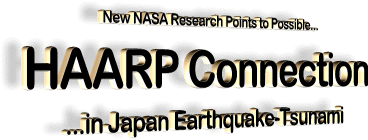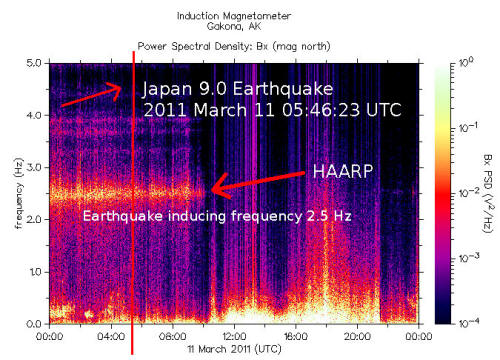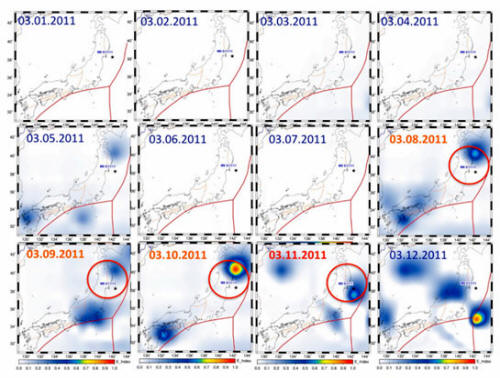|

by Ethan A. Huff
staff writer
June 10, 2011
from
NaturalNews Website
Recent data released by Dimitar
Ouzounov and colleagues from the NASA Goddard Space Flight
Center in Maryland highlights some strange atmospheric anomalies
over Japan just days before the massive earthquake and tsunami
struck on March 11.
Seemingly inexplicable and rapid heating
of the ionosphere directly above the epicenter reached a maximum
only three days prior to the quake, according to satellite
observations, suggesting that directed energy emitted from
transmitters used in the High Frequency Active Auroral Research
Program (HAARP)
may have been responsible for inducing the quake.
Published in the Massachusetts Institute of Technology (MIT)
publication Technology Review, the findings are presented alongside
a different theory called Lithosphere-Atmosphere-Ionosphere
Coupling, which hypothesizes that the heating in the ionosphere may
have been caused by the impending earthquake as the fault line
released radioactive radon.
This theory, of course, is not actually
proven, but is instead presented as a possible explanation for the
presence of the high-density electrons and emitted infrared
radiation that was observed.
Another explanation for this strange heating - and one that, upon
analysis, seems much more likely - is that it was an indication that
concentrated energy was used to induce the earthquake, and not the
other way around.
Numerous credible reports and scientific
observations reveal that HAARP technology is fully capable of being
used as a scalar weapon, meaning it can emit strong electromagnetic
pulse bombs that can alter weather or trigger seismic fault lines.
Evidence that
HAARP is not only capable of inducing earthquakes
...but that it appears to have been used on Japan
A casual glance at the graphics presented as part of Ouzounov's
research data shows near-perfect heat rings present above the
epicenter of the quake.
If radon emissions from the fault line
were truly responsible for creating these heat zones, they would
more than likely have had irregular, scattered appearances, rather
than concentric circles. This anomaly by itself debunks the theory
that the impending earthquake caused the heat patterns.
Also, readings from the HAARP Induction Magnetometer, which
visualizes the frequency spectrum of signals detected in the earth's
geomagnetic field, show that a steady, ultra-low frequency (ULF) of
roughly 2.5 Hz was being broadcast days before the earthquake.
The 2.5 Hz ULF happens to be the exact
same frequency as the natural resonance produced by an earthquake -
and since there were no constant earthquakes occurring on the days
before the quake as the HAARP Induction Magnetometer appeared
to indicate, the logical conclusion is that the signal was being
broadcast to induce the quake:

http://presscore.ca/2011/?p=1624
Some would argue that HAARP is not
capable of producing such frequencies, especially at the power
levels that would be required to induce a massive earthquake like
the 9.0+ that occurred in Japan.
But testimony by various
governments says otherwise.
On April 28, 1997, then US Secretary of Defense William S. Cohen
gave an important keynote address at the Conference on Terrorism,
Weapons of Mass Destruction, and US Strategy at the University of
Georgia in Athens.
When asked a question about terrorism,
Cohen had this to say as part of his response about the type of
technology that existed, even back then:
"Others are engaging even in an
eco-type terrorism whereby they can alter the climate, set off
earthquakes, volcanoes remotely through the use of
electromagnetic waves".
(http://www.defense.gov/transcripts/transcript.aspx?transcriptid=674).
This admission counters the claims made
by some that no such technology exists, and that it is impossible to
create seismic activity using directed energy.
Clearly the
technology has been around for a while, and the notion of it being
used as a weapon is anything but a baseless conspiracy theory.
Then, there is the EU report on the environment, security and
foreign policy, that was
released on January 14, 1999.
This report outlines various types of
weapon threats, including a section entitled,
"HAARP - a weapons system which
disrupts the climate."
The paper explains that HAARP is,
"run jointly by the US Air Force and
Navy," and that one of its purposes is "to heat up portions of
ionosphere with powerful radio beams."
It also states the following important
details:
"HAARP can be used for many
purposes. Enormous quantities of energy can be controlled by
manipulating the electrical characteristics of the atmosphere.
If used as a military weapon this can have a devastating impact
on an enemy.
HAARP can deliver millions of times
more energy to a given area than any other conventional
transmitter. The energy can also be aimed at a moving target
which should constitute a potential anti-missile system."
Later references to HAARP describe it as
"a matter of global concern," emphasizing that most people have no
idea it even exists.
This was written, of course, more than a
decade ago - and yet not much has changed since that time, despite
several pushes to make HAARP more transparent.
But if HAARP is truly responsible for
helping to induce some of the seemingly natural disasters that occur
in the world, it is no surprise that the program continues to be
kept largely under wraps.
Visit the
HAARP Fluxgate Magnetometer.
Atmosphere Above Japan Heated Rapidly...
Before M9 Earthquake
May 18, 2011
from
TechnologyReview Website
|
Infrared emissions above the
epicenter increased dramatically in the days before the
devastating earthquake in Japan, say scientists. |

Geologists have long puzzled over
anecdotal reports of strange atmospheric phenomena in the days
before big earthquakes.
But good data to back up these stories has
been hard to come by.
In recent years, however, various teams have set up atmospheric
monitoring stations in earthquake zones and a number of satellites
are capable of sending back data about the state of the upper
atmosphere and the ionosphere during an earthquake.
Last year, we looked at some fascinating data from the DEMETER
spacecraft showing a significant increase in ultra-low frequency
radio signals before the magnitude 7 Haiti earthquake in January
2010
Today, Dimitar Ouzounov at the NASA Goddard Space Flight
Centre in Maryland and a few buddies present the data from the
Great
Tohoku earthquake which devastated Japan on 11 March. Their results,
although preliminary, are eye-opening.
They say that before the M9 earthquake, the total electron content
of the ionosphere increased dramatically over the epicenter,
reaching a maximum three days before the quake struck.
At the same time, satellite observations showed a big increase in
infrared emissions from above the epicenter, which peaked in the
hours before the quake. In other words, the atmosphere was heating
up.
These kinds of observations are consistent with an idea called the
Lithosphere-Atmosphere-Ionosphere Coupling mechanism. The thinking
is that in the days before an earthquake, the great stresses in a
fault as it is about to give cause the releases large amounts of
radon.
The radioactivity from this gas ionizes the air on a large scale and
this has a number of knock on effects. Since water molecules are
attracted to ions in the air, ionization triggers the large scale
condensation of water.
But the process of condensation also releases heat and it is this
that causes infrared emissions.
"Our first results show that on
March 8th a rapid increase of emitted infrared radiation was
observed from the satellite data," say Ouzounov and co.
These emissions go on to effect the
ionosphere and its total electron content.
It certainly makes sense that the lithosphere, atmosphere and
ionosphere are coupled in a way that can be measured when one of
them is perturbed. The question is to what extent the new evidence
backs up this idea.
The Japan earthquake is the largest to have struck the island in
modern times and will certainly turn out to be among the best
studied.
If good evidence of this relationship doesn't emerge from
this data, other opportunities will be few and far between.
Reference:
|


